Queuing up a misbuilt deck is among the easiest ways to lose at Hearthstone before games even begin. This may become especially true following the release of Descent of Dragons (DoD), as the set promises to bring some of the most powerful cards the game has seen in some time. Build your decks wrong and you may end up bringing a metaphorical knife to a gun fight. You’ll be outclassed, outgunned, and ready to throw your phone out the window in tilt.
Being constrained to 30-card decks, you need to ensure your decks contain the optimal packages of cards. If your pursue a weak theme too heavily at the expense of independently-better cards, your decks will suffer. If you pursue a strong theme without going hard enough after it, you may fall short of your potential.
With that in mind, let’s get down to some themes you may want to build around in Rogue, why some cards get included in these packages, and why others might not. Hopefully the lessons learned here can help you focus our deck building in other classes as well (provided you want to play a class other than Rogue for some weird reason).
In the later part, I’ll also showcase some ready builds. Click here if you want to jump straight to theorycrafts.
The Burgle Package
The main strength of the Burgle package is the tempo provided by Underbelly Fence and Vendetta. A 2-cost 3/4 with Rush and 0-cost 4 damage spell is great for getting control of the board and making sure you are dictating what minions are doing there. This is how games are won.
DoD brings a new contender to the Burgle package in the form of Dragon's Hoard. We have seen from the Wild event just how important a card like Swashburglar is for both increasing the consistency of activating Fence and Vendetta and getting bodies on the board early. Dragon’s Hoard doesn’t give you the 1/1 body as Swashburglar does, but it still allows you to activate your powerful tempo tool early while also working against other Rogues.
Note that what is not strong about the Burgle package – or at least what its primary strength isn’t – is the ability to generate value or find the correct answers. The value from Burgled cards is a nice bonus (kind of like “drawing,” say, 70% of a card, as they tend to be weaker than what you include in your deck on purpose), but it’s not the reason you’re playing them. Their flexibility is – at best – a crapshoot. We want to ensure we have enough cards to get our synergies active early, but limit our Burgle cards to only the best of the bunch.
For this reason, we don’t want cards like Academic Espionage or Pick Pocket which end up costing too much mana for too unreliable and delayed an effect. Spirit of the Shark runs afoul the same issue: generating many resources isn’t how we are trying to win the game with this package, and so it doesn’t further our game plan in that respect.
The Shuffle Package
This is a new potential tempo package offered up by Stowaway. It represents risky and uncharted territory in deck building with the promise of huge rewards if executed well.
The general idea is this: Stowaway is a 5-cost 4/4 minion that draws 2 cards which did not begin in your deck if there are any in there. On its own, then, this card is bad as you need to put in work to add cards to your deck before you get a payout. Before that point, the card is dead.
Now while a 4/4 for 5 that drew 2 cards would be a good bargain, we can do better. As mentioned above tempo – putting stats onto the board – tends to win games. For this reason, we have included 2 copies of Portal Keepers and Shadow of Death, as well as one Waxadred. The ideal case here is to play one of your 4-cost cards on turn 4 and follow it up with Stowaway. That would get you the 4/4 body, plus 2 additional minions (either 2/2s with Rush or whatever you pointed Shadow of Death at), plus two cards (as the portals and shadows both trigger a draw effect when they auto-cast). Waxadred’s Candle can do something similar in the event it has already died.
However, as discussed above, we’re looking for tempo. We want to develop the board and not just draw cards. For this reason, I would not consider cards like Academic Espionage and Lab Recruiter as core to the shuffle package. With Lab Recruiter might make a decent addition to reach a critical number of shuffle effects (ensuring the Stowaway is active), the cards it draws are much slower than the other options. Academic Espionage is simply too unreliable and slow to guarantee being useful, so we don’t bother. Similarly, the 6-cost Portal Overfiend doesn’t curve out well enough with Stowaway, and so isn’t included.
Where this package may fall down is that all the cards are individually bad. While the synergy between them may prove an incredible tempo tool when paired together, failing to find one half or the other leaves you with bad cards. Make sure you have a backup plan in your deck for when this doesn’t work.
The Galakrond Package
The Galakrond hero cards offer huge payoffs for investing in them. In Rogue, those come in the form of drawing up to 4 cards and making them cost 0 while developing a 5/2 weapon when you have invoked 4 times, as well as offering 3 coins from Umbral Skulker when you have invoked twice. Kronx Dragonhoof draws your big payoff (or becomes another one if you’re already in Galakrond mode). As you’re generating a lackey with each Invoke, Heistbaron Togwaggle also becomes an easy inclusion, as all those cards make him better.
In this case, the Galakrond, the Nightmare package is relatively straightforward because each card makes the others better and the options are limited. We simply don’t have too many choices of Invoke cards and payoffs, so we play them all.
The interesting part of this package concerns the secondary cards that float around it: what cards interact well with the ones above.
These are the notable examples that come to mind. Shadowstep works well with Invoke minions, the lackeys they generate, or Skulker for more coins. Edwin VanCleef and Questing Adventurers work well with lackeys and coins, as well as the 0-cost cards you can draw off Togwaggle and Galakrond. Spirit of the Shark can turn your Invoke minions into double Invokes, double the power of the lackeys you get from Invoking, get 2 triggers off Kronx, and make Umbral Skulker give you six coins, radically boosting the power of Questing and Edwin.
The major problem with Shark has always been the tempo you gave up to play it: spending 4 mana for a 0/3 requires you put in a lot of leg work just to break even, let alone get ahead. It is possible that all the new interactions with the Galakrond package can offset those initial tempo downsides to the point you end up ahead more often than not. Then again, maybe you’re still just better off spending that 4 mana to do something else. Time will tell, but it should at least be worth experimenting with again.
The Deathrattle Package
The new toy from Descent of Dragons that Rogue gets to experiment with is Necrium Apothecary: a 4-cost 2/5 with the combo of “Draw a Deathrattle minion from your deck and gain its Deathrattle.” This card looks so deck-definingly powerful it might bring together this entire deck. As the 4-cost minion curves out nicely from a 3-cost Necrium Blade that can trigger its deathrattle immediately, we have an even stronger potential there.
As above, let’s use the simple (and correct) rule that tempo is good. In order to maximize the power of the Apothecary, we need to make it generate as many stats as possible. Towards that end, we only want to play Deathrattles that put stats onto the board, and that means playing two copies of Mechanical Whelp (which make 7/7 Mechs) and one copy of Cairne Bloodhoof (because I can’t play three Whelps and want enough synergy to ensure a hit both Apothecarys if possible. That said, simply ensuring one hit might be enough).
The ideal curve, then, is to play a Necrium Blade on 3 and attack. Turn 4 you follow that up with a combo’d Apothecary, get a Mechanical Whelp in your hand, break your blade, make a 7/7, and have a 2/5 on board that has another 7/7 hanging out inside of it. Because that’s a mech, you can magnetize a Zilliax onto it for a huge stabilizing punch on 5, then just go ahead an play the Whelp you drew on 6.
Notice how much better that play would be than, say, getting a Waxadred with your Apothecary, which puts no stats on the board immediately when you break a blade, and only maybe puts some into play in the far future. We don’t want that. We want our stats now. Playing more deathrattles only dilutes the number of stats we can put onto the board quickly, and that’s no good for us. The same can be said for Blightnozzle Crawler, SN1P-SN4P, or anything of the sort.
You might also think about playing Anubisath Warbringer, as that Deathrattle can pack many stats into your hand and, subsequently, the board. While it’s a slower option (and thus probably worse), it’s not entirely insane and your head would be in the right place, at least. If you want to go that route, you might consider 2 copies of them and an Anka, the Buried, though I suspect that’s overkill.
The Pirate Package
Perhaps hitting people in the face is more your style. In that case, I might be able to interest you in an aggressive pirate package for Rogue. The strength of this package has already been seen in aggressive Rogues for the last many months, but new power comes in the form of Parachute Brigand and Bloodsail Flybooter.
The Flybooter is a 1-cost 1/1 Pirate that adds 2 1-cost, 1/1 pirates to your hand as a battlecry. Rogue likes this effect a lot because it gives you early tempo without sacrificing card advantage and banking combo activators or cheap bodies for later. This card is so good, in fact, I anticipate it going in most Rogue decks moving forward for reasons I’ll discuss in the “good cards” package.
However, because it is a pirate, playing it will activate Parachute Brigand, which is a 2-cost 2/2 Pirate that plays itself from your hand for 0 mana when you play another Pirate. This effectively makes the card a 0-mana 2/2, which is a ton of tempo early in the game. It’s reminiscent of Happy Ghoul, which Zoo decks used to play, and can simply get your opponent for a ton of damage before they’re prepared to react.
Since you’ll need more Pirates than just the Flybooter to make the Brigand work, we have included our Standard package of Southsea Deckhand, Dread Corsair, and weapons to give them the punch they need. Throw in Leeroy Jenkins for burst and Myra's Unstable Element for sustained damage and you have yourself a very aggressive list.
While we want to play enough Pirates to make Brigand good, we don’t want to go all in on the Pirate synergy. Many pirates are not particularly good at bursting onto the board and slow stats are not what we’re after. This means cards like Southsea Captain and Nightmare Amalgam might not fit our plan. We want our opponents dead before they can react effectively, and slower, Midrange minions don’t work.
You may want to include a Captain Greenskin as well, but I haven’t included it in the core of this package because Greenskin is mostly good for helping with the weapons, instead of the Brigand. If we find we want another early-game Pirate for consistency in activation, the next best option might be Bloodsail Raider, though the card wasn’t super impressive in the deck last time it tried to run it.
The “Good Card” Package
While there are other Rogue decks you might think about building (Quest, Highlander, and so on), it’s more important to finish by covering the generic-brand, good Rogue cards. We can’t get so tunnel-visioned on a theme of our deck to the exclusion of other cards that are simply independently strong. As many of these faces are familiar I won’t cover what makes them all good, but I will look at the new options from DoD.
Perhaps the strongest of these is the newly-released Faceless Corruptor. A 5-mana 5/4 with Rush that, on Battlecry, transforms a friendly minion of your choice into a copy of it (another 5/4 with Rush). In terms of stats, then, that’s a 10/8 worth of Rush for 5 mana, which is an absurd tempo push. Things get even better for Rogue, as the class can generate make 1/1 minions in the form of Lackeys, Flybooter tokens, or might just use an existing body on board (damaged or not) to reap the rewards of the Corruptor. Simply put, this card looks so strong that it’s probably going to increase your win rate more than any of the above packages, on average. It’s all but mandatory in all Rogue lists moving forward if your goal is to win.
Flik Skyshiv’s power level is lower, but it’s still quite strong. A 6-cost 4/4 that destroys a minion on Battlecry and all copies of it, whether in player’s hands, on their boards, or in their decks. It compares well to Vilespine Slayer, which was a card most Rogue decks used to run in the past, with the added bonus of sometimes making an opponent discard a card or losing multiple minions on board. It’s a powerful yet simple option that’s probably good enough to slot into any Rogue list easily. Just be careful where you point it, as it can blow up your own minions as well if you point it at a card you share in common with your opponent.
Descent of Dragons Rogue Theorycraft Builds
Below, we’ll look at some sample deck lists I have put together that utilize these different packages. However, feel free to stitch together your own lists using packages above as a guide and filling in the blanks for yourself.
While thinking about cards in terms of what their optimal packaging can be a useful exercise, at some point the rubber needs to hit the road and we need to make decisions about what goes into our decks, what cannot, and why.
Sometimes this is going to mean making painful cuts to our lists and taking out cards we think are really powerful or cool in favor of cards and strategies that are simply better.
In the process of doing that, one key rule to follow is that, at least initially, always try to build your deck to accomplish its own objectives; don’t try to stop what you anticipate your opponent’s plans to be. You need to make sure you’re doing something fundamentally good enough consistently enough before you even think about specifically trying to counter an opponent’s strategy (forgoing your ability to even successfully predict what your opponent’s will be doing).
Basically, do you first. Worry about others later.
With that in mind, let’s get cracking on some potential Rogue builds. Understand that these are first drafts, and may be subject to change as we can actually test these cards out.
The Free-to-Play Tempo Rogue
Coming in at a mere 4,840 total dust, this deck leverages the Burgle package to provide powerful early-game tempo swings. In fact, pretty much everything about this deck is focused on either (a) putting out as many stats as you can for the amount of mana you have, (b) removing stats from the opponent’s side of the board, or (c) both of these at once. Your aim is to hit your curve, playing minions onto the board each turn. Use your cheap minions to transform into the powerhouse of Faceless Corruptor copies and finish your opponent with a massive push of stats.
With the amount of minions you should be playing and the removal options available to Rogue, Troll Batrider becomes an interesting possibility. A 4-mana 3/3 that on Battlecry deals 3 damage to a random enemy minion looks a lot like Flanking Strike; a Hunter card that saw plenty of play in its time. While the “random” word may scare people off, between your minions and removal options, including your dagger, there’s a good chance you should be able to reliably guarantee this damage hits a minion you want it to.
If the Legendaries of Edwin VanCleef and Flik Skyshiv are too rich for your blood, feel free to replace them with cheaper tempo-based cards, like Sap or Hench-Clan Thug.
Galakrond Rogue
Jumping into the opposite end of the spectrum, Galakrond Rogue is one of the more expensive Rogue decks you could build this next expansion, coming in at about 10,000 total dust. However, since we get the Galakrond, the Nightmare for free, that no doubt inspires many people to build around it, and this is one way of doing so (there are others, and I’m not at all sure what the best will be yet).
This is a Hybrid Combo/Tempo list. Your goal is to try and keep your opponent off the board in the early game (getting it yourself if you can) as you Invoke your Galakrond, picking up a Lackey each time (coincidentally, these lackeys can help you keep that tempo), especially when combined with Faceless Corruptor. Make sure to play for the board as often as you can.
Once you have Invoked 2-4 times, this deck can go off quickly. The coins from Umbral Skulkers can radically boost up a Questing Adventurer or Edwin VanCleef, as can the 0-cost cards you draw off Galakrond and King Togwaggle. If you’re in Galakrond Rogue, Kronx Dragonhoof can push huge amounts of tempo, and combining many of the minions with Spirit of the Shark (especially when things start costing 0) can truly make for huge moments.
Shuffle Rogue
If you’re interesting in Gnoming people, you can now do so for real in Hearthstone. Much like the Gnome meme, this deck may also be a meme or something truly powerful. Only time will tell on it.
The game plan is close to identical with the Free-to-Play Tempo/Burgle Rogue from above. This utilizes many of the same cards to capture the early game board, but operates with bigger (and less consistent) payoffs. The ideal play is a turn 4 Shadow of Death (on your minion or an opponent’s) or a Portal Keeper, into a turn 5 Stowaway that then draws 2 cards while summoning 2 minions, giving you a massive tempo push.
Aggro Pirate Rogue
If you want to hit your opponent in the face, this is the deck for you. It resembles the aggressive Raiding Party lists of previous metas with a few new tools. Get on board early and fast, finish with burst. Simple and respectable.
Blazing Battlemage and Bloodsail Flybooter offer this deck something it was badly looking for for some time: better 1-drops that can hit the board on curve and/or act as cheap combo activators in the later stages of the game. Both of those help this game plan a lot. This deck used to operate much differently when it had the coin, and now that difference may be minimized.While these decks used to cheat tempo primarily with weapons and Dread Corsair, we may get to double-dip with the Parachute Brigand, putting stats on board even quicker for 0 mana. It’s possible this deck might want an additional Pirate to increase consistency a bit more in the early game and, if that’s the case, feel free to reach for Bloodsail Raider, as its weapon synergy has some other implications in this list.
Deathrattle Burgle Rogue
Like most good Rogue decks, this one follows the tempo-based game plan of above with the potentially-huge power spike offered by Necrium Apothecary and Necrium Blade. Get the early board and quickly snowball it with 7/7s to crush most opponents before they know what hit them.
One notable exclusion form this deck is Necrium Vial. While it might seem like that’s a good card for a deck with Deathrattles it is both slow and conditional, which are two words I do my best to avoid when possible. Vial is such a late-game consideration that its most common usage in this deck would be sitting in your hand, taking up space.
While this is a Deathrattle deck, that component is relatively small. We only want the best Deathrattles; not every one.
Only Time Will Tell
While many of these ideas sound great in my head (and no doubt you have some of your own), only time will tell what makes the cut and what doesn’t. After all, we don’t play Hearthstone in a vacuum, and the other cards/decks in the game will help determine what cards we are allowed to play successfully.
These are merely the first words in thinking about deck building in the new meta; not the last. Perhaps the meta is too aggressive for a Galakrond deck to be great (or at least require that it play more defensive cards). Perhaps there are other archetypes not seen here that ultimately end up being stronger. But I think we have some good first steps here.
Leave a Reply
You must be logged in to post a comment.

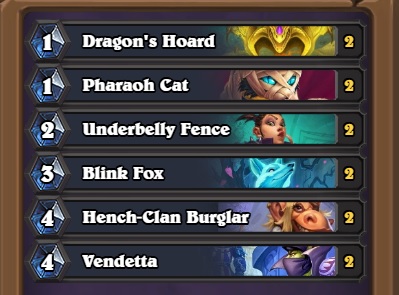
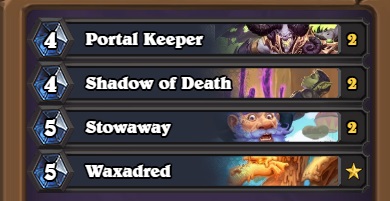
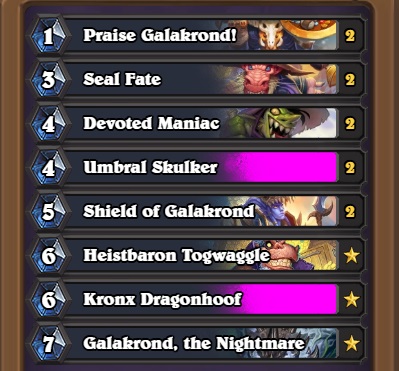
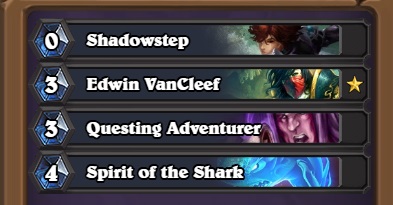
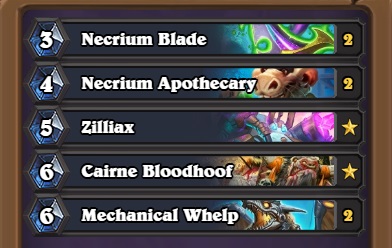
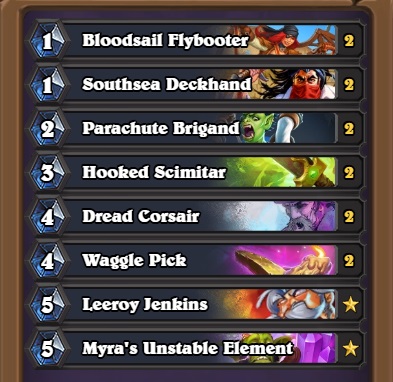
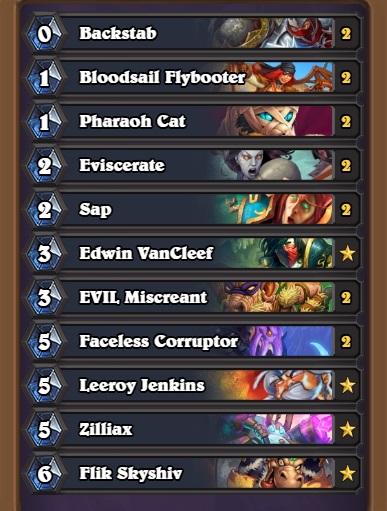











































An excellent, deep article! Thanks!
This is an excellent article. Very excited to get started with the new cards.
No combination of Deathrattle package and Waxadred? I can See Apothecary, Waxadred, some shuffle copies effect (just in case you draw Waxadred early) and Lots of draw.
Or is this to playful to be competitive?
I’m thinking shuffling as many Waxadreds and Candles as possible into deck then just waiting to have full field of Waxes for the rest of game. Sure I need to think carefully what else to include to keep my poor rogue alive. Probably mostly meme, but gotta try.
Thank you, i’m looking forward to playing these decks ????
Best article ever, thank you a lot.
FANTASTIC article. If i were to challenge anything, it would be Devoted Maniac: at 4 mana for a 2/2 rush, I think it is just to much tempo loss for Rogue and the invoking isn’t a big enough reward for the risk. Shaman Gal and Warlock Gal get immediate bodies so they get immediate stats, Warrior Gal gets a free swing which they can use to remove an opponent’s minion, and Priest Gal is premusably playing control so they can weather tempo loss. But for for Rogue Gal I think it feels terrible to play that card on curve and above curve you’re really hoping for a witchy lackey so you can evolve it.
great way to explain the way of deck making.
THANK YOU ALL!
Now, This! is how you write an article to encourage a dynamic week one meta.
As well as teaching people why their decks work, and not just playing something and realizing… wait why is this so good?
Excelente artículo. Muchas gracias.
Truly excellent article, thank you for taking the time in making it.
I’ve been playing HS since 2014 and I still suck hard at making my own decks. This is the perfect article to encourage and help with that. Not only can you use it to create your own day one decks but you can apply the same ideas to other classes as well.
I really hope we get similar articles for the rest of the classes.
Had to login just to say thanks for such a great article.
Me too. Really great article!
Nice article, thank you.